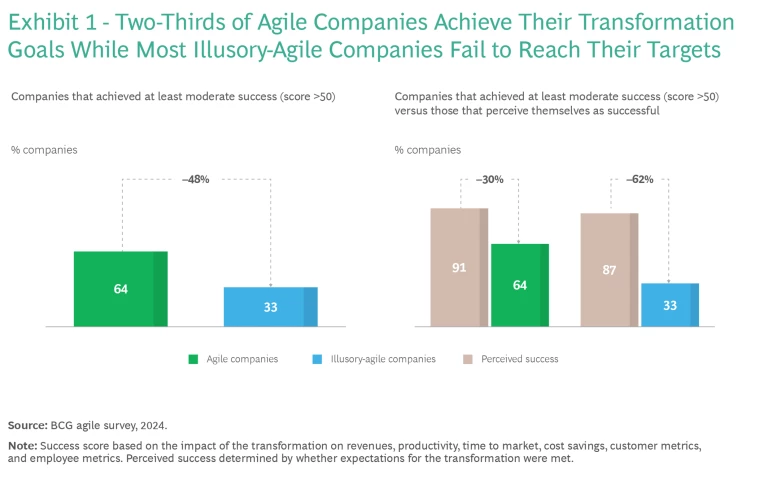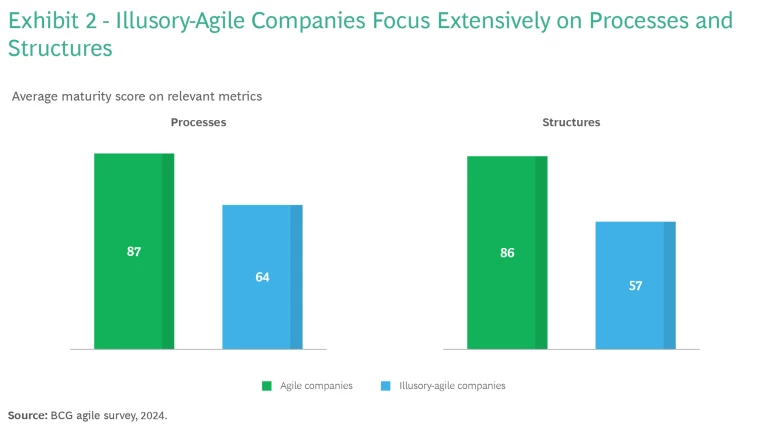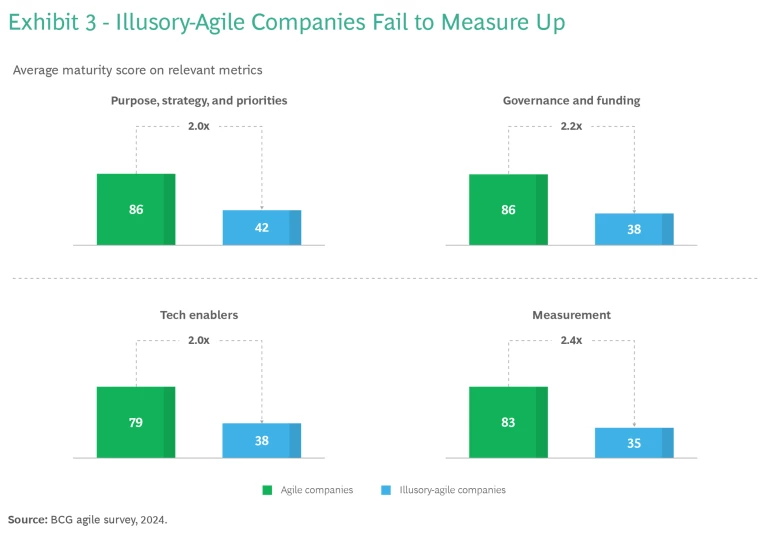Ask a CEO about agile today, and the response is likely to be, “Been there, done that, moved on.” Many leaders ought to take another, deeper look: our latest research reveals that only about half of the companies that claim high agile maturity have actually achieved their transformation goals and can point to real business impact.
We conducted in-depth research with 127 companies worldwide regarding their experience with agile. Almost all (94%) had embarked on agile initiatives, and two thirds (66%) claimed successful agile transformations. But when we asked which agile practices they applied and what outcomes they achieved, we found that only about half (53%) could be considered truly agile, realizing their transformation targets and creating lasting change in their culture, ways of working, and ways of teaming.
The other half (47%) wrongly believe that they are agile. But in fact, they are operating under the illusion of agility: they have adopted the agile practices and are claiming some success, but they are not reaping the benefits of improved performance in the form of higher productivity (15% to 20% reduction in delivery costs), faster time to market (two to four times faster product delivery), and greater financial benefits (twofold increase in total shareholder return).
Why do companies fail to reach the full potential of agile ways of working? And what can they do to become truly agile and reap the benefits?
Illusory Agile
We took a comprehensive and objective look at what it means to be an agile company and what constitutes success. We examined the changes companies made to their operating models, and we looked at the metrics that define the success of agile transformations. (See the sidebar, “Agile Accounting.”)
Agile Accounting
We scored impact from negative (-1) to significant (1). A successful agile company had to be able to measure the impact of its transformation across all these metrics and achieve at least moderate success (0.5) against each one. In other words, a successful transformation had to show positive effects in all dimensions, not just one or two.
The share of truly agile companies was highest in the technology, media, and telecommunications (50%) and financial services (48%) sectors. Consumer and insurance companies (both 25%) were the least successful. The percentage of illusory-agile companies was roughly even in Europe and North America (41% and 36%, respectively) and notably low in Asia (7%).
We then compared the companies that perceive their transformations as successful with those that truly achieved success. Similar percentages of agile companies (91%) and illusory-agile companies (87%) perceive themselves as successful, though some companies in both groups overrate their success. But when you look more closely, by a rate of almost two to one, agile companies realize their goals while illusory-agile companies overestimate their results, according to the eight metrics we tracked. (See Exhibit 1.)

Perhaps the single biggest reason for the difference in perception is that, although illusory-agile companies focus extensively on agile structures and processes, they do not look beyond the surface to implement key agile practices more broadly and achieve real business impact. (See Exhibit 2.) All companies set up agile structures, of course, such as squads and tribes, but illusory-agile companies tend to confine these changes to IT, rather than involving the full business in the reorganization. They overemphasize visible levers (they organize in squads, run sprints, and appoint product owners, for example), which give the illusion of progress. But they do not make the more difficult and substantive changes, such as establishing customer-facing business units fully aligned to value streams, setting up enabling supporting structures that own internal products and platforms, and resetting incentives and rewards. They are much less likely to create a structure with shared capabilities between the business and IT across the organization and involving the business units.

The shortfalls and disconnects do not end there. Illusory-agile companies also fail to make lasting adjustments in four key facets of the operating model, where bringing about real change is often most difficult. (See Exhibit 3.)

Purpose, Strategy, and Priorities. Corporate strategy lies a long distance from most teams’ daily tasks, and many employees have trouble relating what they do each day to what the broader organization is trying to achieve. Agile companies use measureable objectives and key results (OKRs) linked to company objectives to bring purpose and strategy down to the team level.
More than twice as many agile as illusory-agile organizations establish “an unbroken chain of why” that connects the business outcomes that the company needs to achieve and the work that individual teams are charged with delivering.
Agile and illusory-agile companies also differ in the goals that they set. For example, 77% of illusory-agile firms make improving time to market their primary goal. Successful agile companies target a broader and more balanced set of transformation objectives, with time to market (66%), productivity (61%), and costs (50%) being at the top. Agile companies don’t need to choose between faster delivery or cost cutting or better products; they can do all at the same time and still be effective.
In our client experience, a big mistake many companies make relates to scope. Businesspeople too often see IT as a bottleneck rather than a partner, so they focus on speeding up IT. If they were instead to collaborate more closely (having product owners from business and not only IT, for example), they would be able to achieve broader goals, including cutting costs or producing better products by streamlining or reinventing end-to-end processes and improving business and IT employees’ collective productivity.
Agile companies don’t need to choose between faster delivery or cost cutting or better products; they can do all at the same time and still be effective.
Agile companies also are much better positioned to embrace the latest technological advances. For example, 14% of agile companies report that they use generative AI at scale to create and prioritize business cases, while no illsuory-agile companies do so.
Governance and Funding. Agile and illusory-agile companies also differ in how they handle governance issues, such as decision making, portfolio prioritization, and budgeting mechanisms. While agile companies make significant changes in governance (86%), illusory-agile companies address these factors at a much lower rate (38%). As a result, they do a poor job of adopting iterative governance cycles that allow for frequent performance reviews, reprioritization, and funding reallocation. They do not adapt measurement systems to focus on customer centric metrics. And leadership doesn’t have real-time visibility into the status and outcome of ongoing initiatives so it can intervene when necessary in a timely manner.
Successful agile companies rely on integrated, iterative governance mechanisms (such as annual and quarterly business reviews) and decision-making tools (such as OKRs) to help ensure “real” discussions about their plans and about how to prioritize their work and plan from a joint business and IT perspective. They are also better at deciding—and sticking to—what not to do. The alignment between business and IT, along with strong technology capabilities, gives agile companies the ability to work more efficiently and effectively, reducing waste and friction, lowering costs, and boosting productivity. These companies also learn and adapt more quickly because they monitor progress through annual and quarterly business reviews and can easily adjust delivery pipelines and tools.
Tech Enablers and Data. Modern tech systems and architecture and platform operating models give agile companies real-time transparency into which activities are in the works and where they are spending their time and money. They provide visibility on the results and ROI of these investments. Digital champions have shown that when companies foster data-driven decision making, they gain more immediate visibility and insight into customers and processes. As a result, they can respond faster to evolving situations. “Common tech platforms can make it easier for customer-facing business units to access the data they need to do their jobs. This can lead to faster decision making and improved customer service,” one retail executive told us.
Agile companies are far more likely than illusory-agile companies to have fully applied data platforms, DevOps, and modern technology tools (by margins of 68% to 23%, 80% to 31%, and 59% to 13%, respectively). A cutting-edge tech stack is not a precondition for agile, but companies with modern, modular tech architecture are more likely to reap agile’s full benefits. Among successful agile companies, 79% had a high technology score in our survey.
Modern tech systems and architecture and platform operating models give agile companies real-time transparency into which activities are in the works and where they are spending their time and money.
Performance Measurement. Another difference between agile and other companies is how they measure the performance of individuals, teams, and the organization. A common transformation-related mistake for companies is assuming they can measure success in the same ways that they did before. They need to rethink their metrics to be more (internally and externally) customer focused and to link back to company OKRs.
While more than half of agile companies adjust their performance evaluation and incentive programs, less than 5% of illusory-agile companies do. Agile companies move from measuring progress and outputs to measuring impact and outcomes. They automate measurement and over-index on team versus individual performance metrics. Two thirds of agile companies set up new reward and recognition systems, compared with only 13% of less successful firms.
Full Agile Application
Agile is a means to an end, not the goal itself. Companies need to have the courage to make changes beyond what is easy and visible and address hard changes to the operating model. They must also change behaviors, rethink governance and decision-making practices, and invest in technology. Leadership needs to hold itself and the organization to account and reset the transformation, focusing it on outcomes, not practices.
Change is possible, as the 53% of agile companies in our survey demonstrate. We worked with one large European energy service and metering company that was challenged by conflicting priorities, resource clashes, and operational and organizational silos that were hindering collaboration. The company committed itself to deep structural and procedural change, an extensive revamping of its governance practices and funding logic, and full integration of the business and IT. Key elements of the transformation involved the following:
- Extensive Change in Organization. The company adopted a top-down approach, integrating business and tech in stable squads and tribes, which were oriented by value streams organized around customer journeys and which reported to the CEO.
- Rigorous Prioritization and Commitment. Corporate strategy was translated into prioritized themes for each tribe, which was assigned its own OKRs. Tribe leaders committed to transparent targets and budgets and KPIs.
- Lean Governance Cycles. The company adopted annual and quarterly business review cycles with a focus on outcomes (such as revenue increases and net new customers) and steered by OKRs and KPIs.
- New Technology Design Principles. The company moved from central IT architectural oversight to tribe ownership and to a BizDevOps model, with DevOps and business efforts jointly prioritized.
In about 12 months, the company was able to define, design, and implement the new operating model. Since then, delivery quality and time to market, employee engagement, and attractiveness to outside talent have all improved.
The success of the company’s transformation is evident. But it is not finished. Beyond the initial transition phase, companies need to stress the importance of continuous learning and adapt to evolving circumstances, including the integration of new technologies. Truly agile cultures emphasize continuous execution, follow-through, and improvement.
Companies under the illusion that they are agile have not necessarily failed. But they do need to refocus their efforts. They should start with a candid evaluation of impact metrics, particularly the areas showing scant progress. It’s crucial to reassess the scope and depth of previous changes and to reconsider aspects previously overlooked. A fundamental question is this: Is the business actively participating in the transformation, working hand in hand with IT and other functions? Make sure the answers are honest. Then make a clear plan for action and execute.
Both agile and illusory-agile companies have a common purpose: an unwavering commitment to outcomes and a culture that champions continuous evolution. By instilling an outcome-focused approach that spans all organizational facets, companies can not only navigate the complexities of the digital age but also seize the myriad opportunities it presents.






